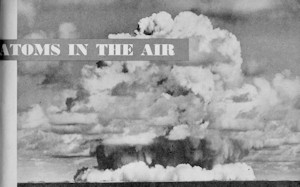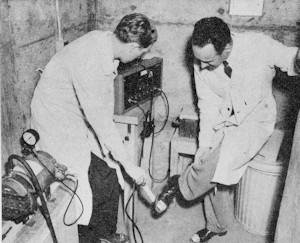|
Atomic
power was going to be the panacea for all the world's energy needs
back in the mid-20th century. Every home would be powered by a personal
nuclear generator, cars and trains would only need to be refueled
once a year. Some military seafaring vessels are powered by nuclear
fuel, but that's about it. This article from the November 1946 edition
of Air Trails details serious studies for a nuclear powered aircraft.
In the end, it was not the ability to build the engine that was
the problem, it was the size and weight of all the lead and concrete
shielding that would be required to protect personnel. Any crash
or accident that caused the reactor cell to be breeched would be
an utter disaster. Of course everyone involved knew that from the
outset, but the government needed to convene a panel, form a research
group, draw up a plan, assemble a team of managers and scientists,
acquire a facility and equipment, implant on-site inspectors and
regulators, do the science, verify the results, write the report,
approve the report, distribute the report, receive feedback from
the report, incorporate suggested changes into the report, repeat
the last three steps, and finally publish the report (unless, of
course, it is a classified report).
Atoms in the Air
 The
Fairchild Engine Airplane Corp. has taken a contract to develop
atomic-powered aircraft for the Army - and the information released
on the subject sayeth no more. But a little simple addition - a
fact here, a fact there - brings up some highly interesting conclusions,
from the facts already generally published. The
Fairchild Engine Airplane Corp. has taken a contract to develop
atomic-powered aircraft for the Army - and the information released
on the subject sayeth no more. But a little simple addition - a
fact here, a fact there - brings up some highly interesting conclusions,
from the facts already generally published.Many discussions
by the atomic scientists in the last year have made it abundantly
clear that atomic engines are not practical for automobiles or ordinary-sized
aircraft, but, that they are practicable for steamships and, possibly,
heavy. large-sized locomotives. The essential trouble with atomic
engines is that atomic energy and human life are simply and absolutely
incompatible. No living thing can come within half a mile of a functioning
atomic powerplant and stay alive - unless there is a monstrous amount
of radiation-absorbing shielding between.

Even a shoe that has touched a floor that was touched by atomic
power can be deadly must be inspected!

There's an atomic pile behind those many-foot- thick concrete
wall but such shields don't fly!
There's a general public misconception that lead is a magic metal
capable of stopping all rays; it's neither magic, nor capable of
stopping radiation as well as a number of other metals, Furthermore,
lead is about the worst of all elements for stopping neutrons thrown
out by an atomic pile - a handful of household borax would do much
better than lead for that job. Lead just bounces neutrons. and sends
them merrily on their way; boron atoms, present in borax, soak them
up like flypaper.The most dangerous radiation from an atomic
engine will be the' X-rays given off by the fissioning uranium atoms;
nothing in the universe can really stop them. Matter, which appears
to our eyes as solid, is purely an optical illusion - quite literally.
Radio waves go right through a house or a brick wall. X-rays go
sailing right through matter. About the only rays that don't penetrate
easily are light rays; the illusion of solidity with which we are
so familiar is due to the fact that we depend on that particular
small part of the spectrum that is blocked by matter. To X-rays,
matter is rather like a gray, ghostly cloud; dense matter is a bit
grayer, low-density matter a more translucent stuff. Lead, because
it has big, complex atoms, and is a dense material, happens to be
a dull, leaden cloud to X-rays. Gold, being twice as dense as lead,
is a much better X-ray stopper. Uranium. it happens, is the best
X-ray stopper of all. The reason lead is standard is easy
to understand, however. The high melting point of gold, platinum,
and similar good X-ray stoppers would make them inconvenient to
use - among other things! Also, it doesn't really make much
difference what matter you use; thick layers of iron, still thicker
layers of aluminum, or thinner layers of lead - all amount to the
same thing, to X-rays. It's the quantity of matter, not the kind,
that counts most. Which is exceedingly unfortunate for aircraft
use! It takes, the atomic scientists say, about 100 tons of shielding
material to stop the X-rays from an atomic engine. If you use lead,
the walls are about two feet thick; if you use aluminum, the walls
will have to be 10 feet thick - and they'll be just as heavy.
Now a 100-ton block of shielding doesn't inconvenience a 20,000-ton
ocean liner, or even a little 5,000-ton tramp steamer, and 100 tons
of weight is handy for giving a locomotive good traction on the
rails. But 100-ton automobiles are too hard to find parking places
for, and 100-ton planes aren't for private airports. To carry a
100-ton engine, actually, the plane would he of the order of 700
to 800 tons minimum - and it would almost certainly have to he a
seaplane. Now it might he that Fairchild's contract calls
for such a super-super colossus - but Fairchild is particularly
noted for fine instrument work, precision-control equipment, and
small-scale, highly-advanced engineering design. There's
another factor to consider, evidently. No human being can live within
half it mile of an operating atomic engine - but a robot can. Electronic
devices don't mind being sprayed with X rays and saturated with
neutrons; neither type of atomic radiation will carry electricity,
nor interfere with electric currents. The two other principal types
of atomic radiation - beta rays (high speed electrons) and alpha
rays (high speed helium nuclei) - are both easy to stop. Ordinary
light-gauge sheet metal can block them. It rather looks
as though Fairchild is interested in a robot controlled atomic-engined
plane of relatively small size - and the possibilities and requirements
are intriguing. It can never be used for human transportation; it's
deadly. It can't be used for freight transportation; the neutrons
sprayed out by the fissioning uranium would render the cargo violently
radioactive for months. Even more interesting, once the atomic
engine has been turned on, no human being can approach the ship
even though the engine is turned off. The neutron spray renders
the entire structure of the plane violently radioactive. The airport
used by such a plane at take-off or landing would similarly be totally
unfit for human use.
Somebody
is going to have to design some really fancy contraptions for that
job! A machine must be designed which under remote control, can
repair, or disassemble the unapproachable atomic plane! Some sort
of machine is apt to he needed. too. for scraping up the remains
of unsuccessful and hellishly radioactive!-Some sort of machine
is apt to be needed, too, for scraping up the remains of unsuccessful
- and hellishly radioactive! - attempts. The entire operation will
have to be directed from a considerable distance, or from inside
many-foot-thick concrete ray-proof shelters. The finished
plane will, evidently, be purely a military device. As such, it
will be a weapon at least as potent as the atomic bomb itself. Such
a plane. as an interceptor, could wipe out a bomber fleet without
firing a shot; it need only fly near the bombers once to destroy
the crew. As an attack plane, it could strafe an armored column
out of existence in one pass, neither heavy steel armor nor ditches
offering any effective protection against its death spray. As a
strafing plane above a city, raining down X-rays and neutrons, it
would offer the would-be defenders two very poor choices: let it
alone while it kills, or knock it down. If you do knock it down,
it will probably be rigged to detonate the atomic engine. It would
be rather difficult to decide which was the worse choice.
Of more interest and more use to mankind, however, will be the
mechanisms that must be developed to service that death-ship. How
would you set about making a machine that could disassemble and
repair another machine under automatic control? How could you design
the atomic plane for easiest - or, at least, possible! - servicing
by mechanical grease monkeys? That sort of design job calls
for high skill and high engineering imagination on small-scale,
precision mechanism. Just the sort of work for which Fairchild is
well and favorably known! The Editor.
Posted January 17, 2012
|